Change Management Framework Analysis Report: IBM Case Study
VerifiedAdded on 2022/11/14
|16
|4186
|409
Report
AI Summary
This report delves into the analysis of change management frameworks, focusing on Kotter's eight-step model and Lewin's force-field analysis. It examines the significance of change management in organizational operations and provides an understanding of how organizations can adapt to changes in the external environment. The report explores the role of managers in shaping organizational culture and presents a case study of IBM to illustrate the impact of change management on corporate culture. It discusses the advantages and disadvantages of Kotter's model, the internal and external forces influencing change, and the resistance to change. Furthermore, the report highlights the importance of managers in fostering a culture conducive to successful change implementation, emphasizing trust, empowerment, consistency, and mentorship as key components of organizational culture. The report provides a comprehensive overview of change management models and their practical applications in real-world scenarios.
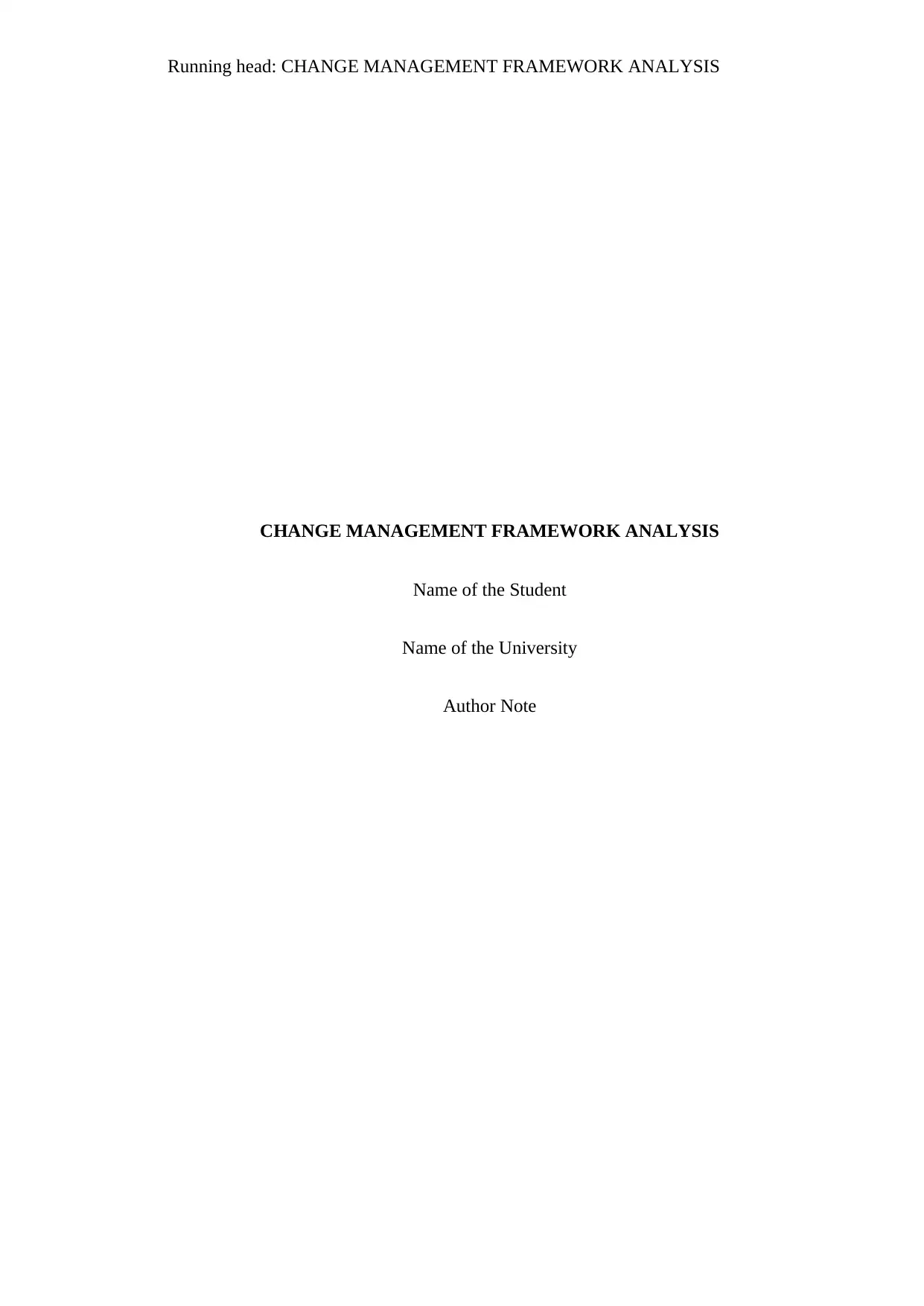
Running head: CHANGE MANAGEMENT FRAMEWORK ANALYSIS
CHANGE MANAGEMENT FRAMEWORK ANALYSIS
Name of the Student
Name of the University
Author Note
CHANGE MANAGEMENT FRAMEWORK ANALYSIS
Name of the Student
Name of the University
Author Note
Paraphrase This Document
Need a fresh take? Get an instant paraphrase of this document with our AI Paraphraser
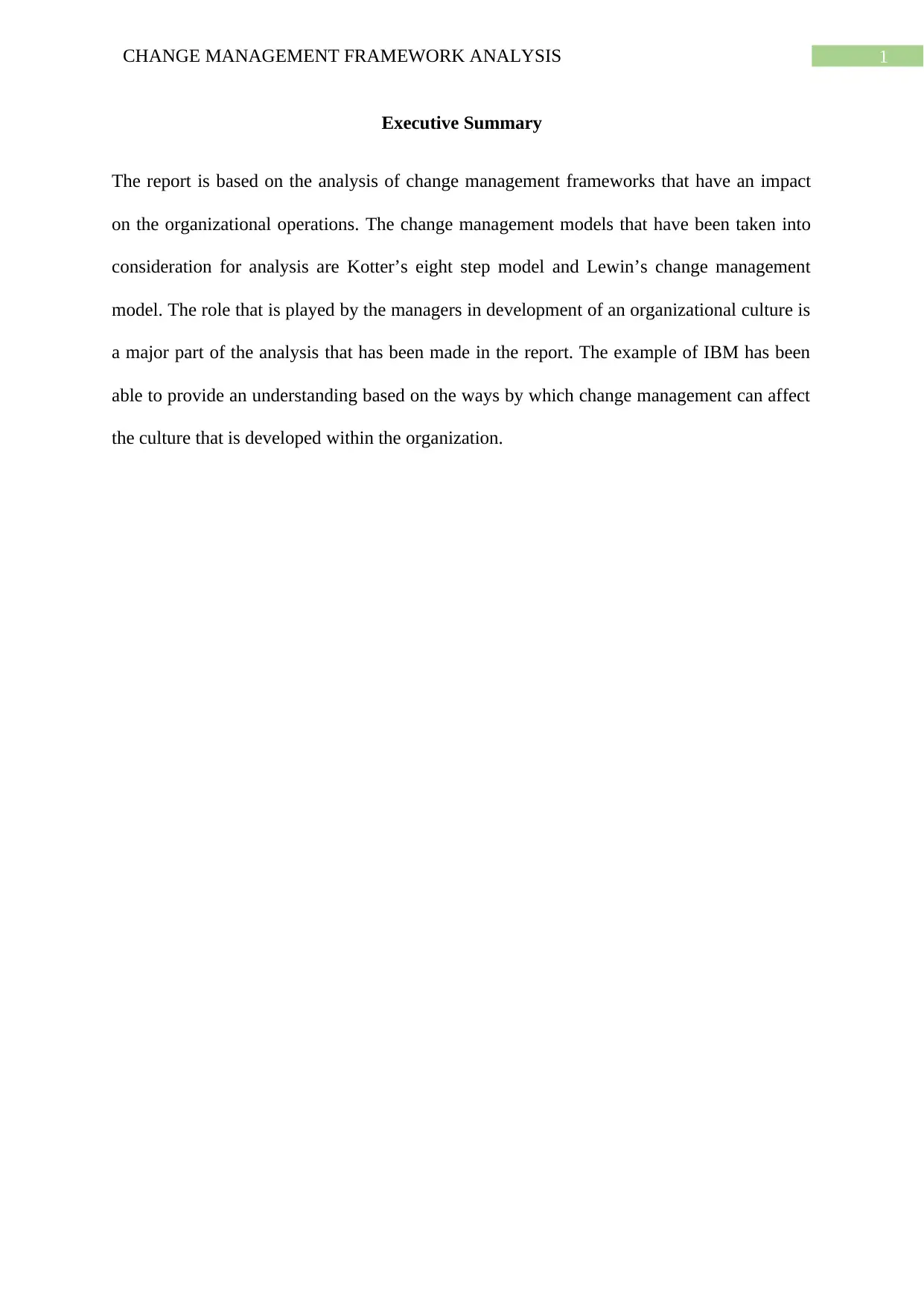
1CHANGE MANAGEMENT FRAMEWORK ANALYSIS
Executive Summary
The report is based on the analysis of change management frameworks that have an impact
on the organizational operations. The change management models that have been taken into
consideration for analysis are Kotter’s eight step model and Lewin’s change management
model. The role that is played by the managers in development of an organizational culture is
a major part of the analysis that has been made in the report. The example of IBM has been
able to provide an understanding based on the ways by which change management can affect
the culture that is developed within the organization.
Executive Summary
The report is based on the analysis of change management frameworks that have an impact
on the organizational operations. The change management models that have been taken into
consideration for analysis are Kotter’s eight step model and Lewin’s change management
model. The role that is played by the managers in development of an organizational culture is
a major part of the analysis that has been made in the report. The example of IBM has been
able to provide an understanding based on the ways by which change management can affect
the culture that is developed within the organization.
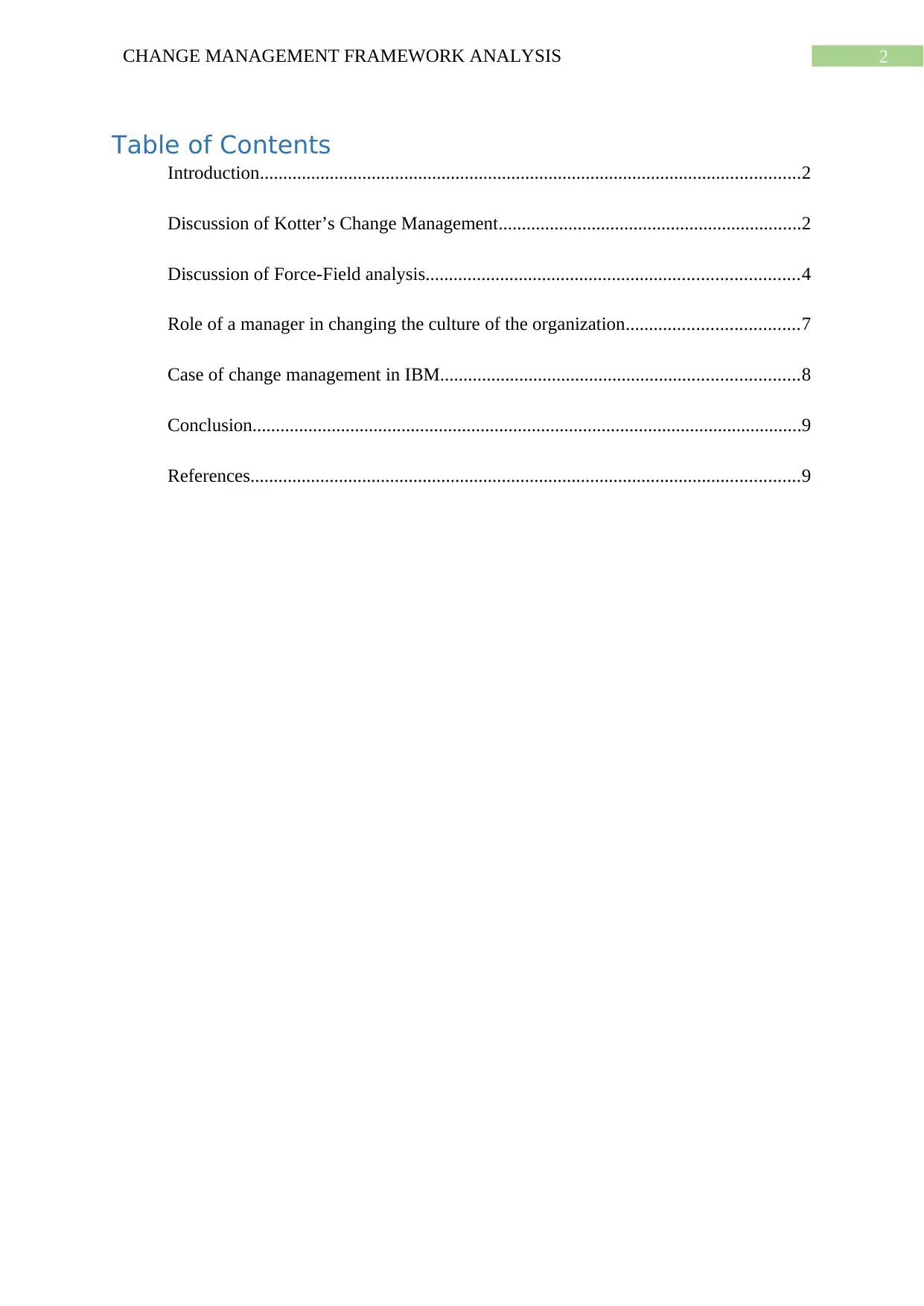
2CHANGE MANAGEMENT FRAMEWORK ANALYSIS
Table of Contents
Introduction....................................................................................................................2
Discussion of Kotter’s Change Management.................................................................2
Discussion of Force-Field analysis................................................................................4
Role of a manager in changing the culture of the organization.....................................7
Case of change management in IBM.............................................................................8
Conclusion......................................................................................................................9
References......................................................................................................................9
Table of Contents
Introduction....................................................................................................................2
Discussion of Kotter’s Change Management.................................................................2
Discussion of Force-Field analysis................................................................................4
Role of a manager in changing the culture of the organization.....................................7
Case of change management in IBM.............................................................................8
Conclusion......................................................................................................................9
References......................................................................................................................9
⊘ This is a preview!⊘
Do you want full access?
Subscribe today to unlock all pages.

Trusted by 1+ million students worldwide
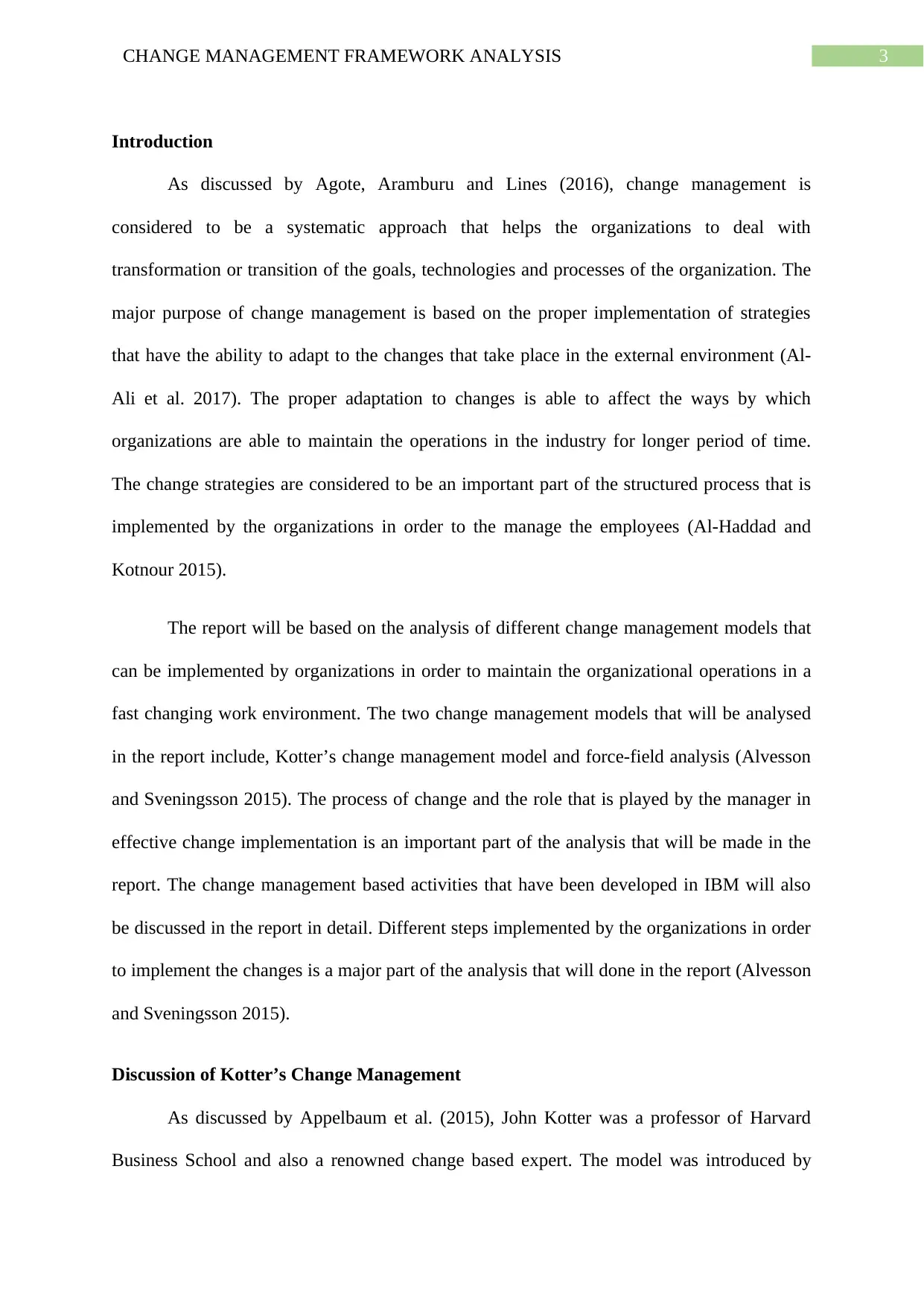
3CHANGE MANAGEMENT FRAMEWORK ANALYSIS
Introduction
As discussed by Agote, Aramburu and Lines (2016), change management is
considered to be a systematic approach that helps the organizations to deal with
transformation or transition of the goals, technologies and processes of the organization. The
major purpose of change management is based on the proper implementation of strategies
that have the ability to adapt to the changes that take place in the external environment (Al-
Ali et al. 2017). The proper adaptation to changes is able to affect the ways by which
organizations are able to maintain the operations in the industry for longer period of time.
The change strategies are considered to be an important part of the structured process that is
implemented by the organizations in order to the manage the employees (Al-Haddad and
Kotnour 2015).
The report will be based on the analysis of different change management models that
can be implemented by organizations in order to maintain the organizational operations in a
fast changing work environment. The two change management models that will be analysed
in the report include, Kotter’s change management model and force-field analysis (Alvesson
and Sveningsson 2015). The process of change and the role that is played by the manager in
effective change implementation is an important part of the analysis that will be made in the
report. The change management based activities that have been developed in IBM will also
be discussed in the report in detail. Different steps implemented by the organizations in order
to implement the changes is a major part of the analysis that will done in the report (Alvesson
and Sveningsson 2015).
Discussion of Kotter’s Change Management
As discussed by Appelbaum et al. (2015), John Kotter was a professor of Harvard
Business School and also a renowned change based expert. The model was introduced by
Introduction
As discussed by Agote, Aramburu and Lines (2016), change management is
considered to be a systematic approach that helps the organizations to deal with
transformation or transition of the goals, technologies and processes of the organization. The
major purpose of change management is based on the proper implementation of strategies
that have the ability to adapt to the changes that take place in the external environment (Al-
Ali et al. 2017). The proper adaptation to changes is able to affect the ways by which
organizations are able to maintain the operations in the industry for longer period of time.
The change strategies are considered to be an important part of the structured process that is
implemented by the organizations in order to the manage the employees (Al-Haddad and
Kotnour 2015).
The report will be based on the analysis of different change management models that
can be implemented by organizations in order to maintain the organizational operations in a
fast changing work environment. The two change management models that will be analysed
in the report include, Kotter’s change management model and force-field analysis (Alvesson
and Sveningsson 2015). The process of change and the role that is played by the manager in
effective change implementation is an important part of the analysis that will be made in the
report. The change management based activities that have been developed in IBM will also
be discussed in the report in detail. Different steps implemented by the organizations in order
to implement the changes is a major part of the analysis that will done in the report (Alvesson
and Sveningsson 2015).
Discussion of Kotter’s Change Management
As discussed by Appelbaum et al. (2015), John Kotter was a professor of Harvard
Business School and also a renowned change based expert. The model was introduced by
Paraphrase This Document
Need a fresh take? Get an instant paraphrase of this document with our AI Paraphraser
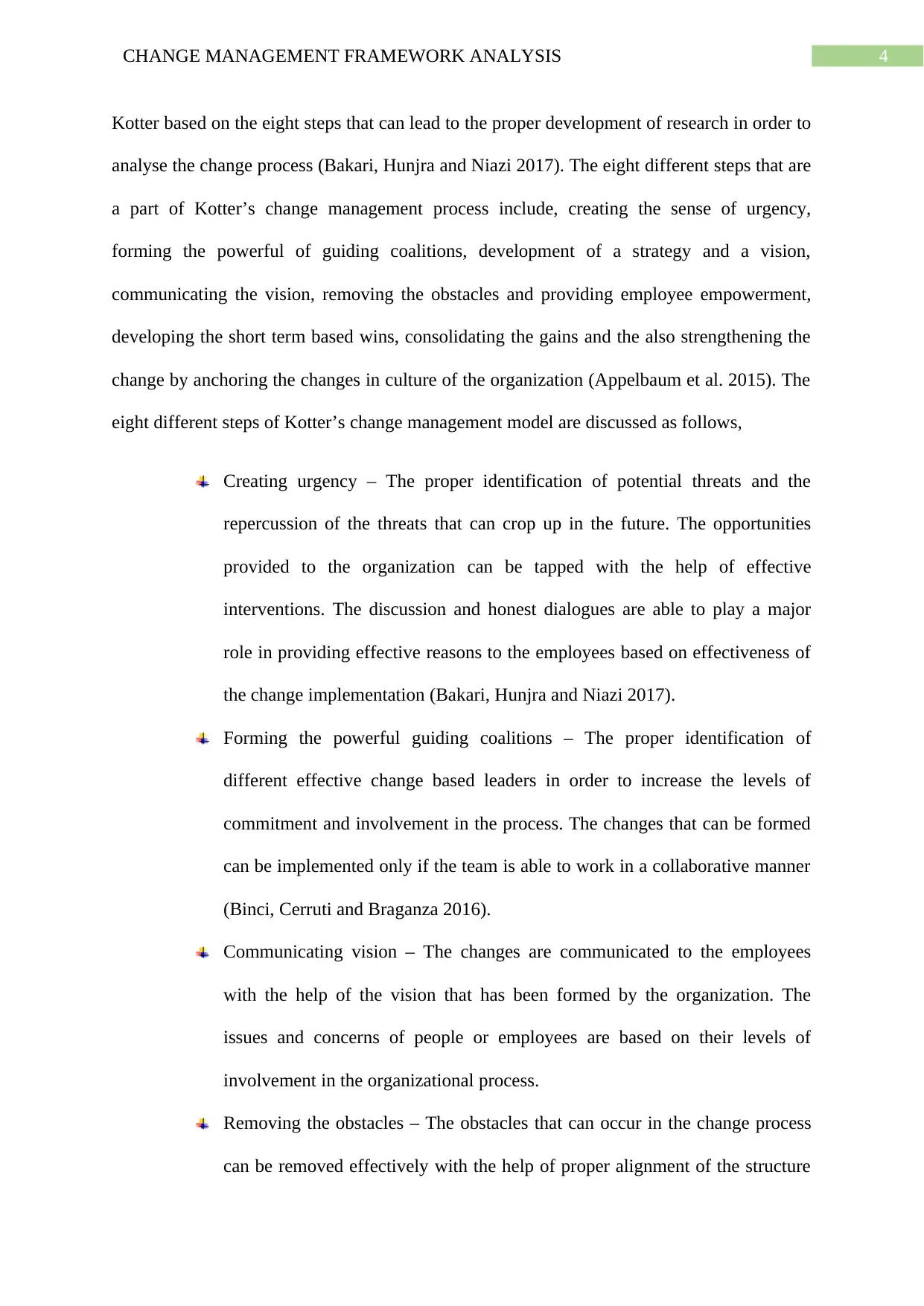
4CHANGE MANAGEMENT FRAMEWORK ANALYSIS
Kotter based on the eight steps that can lead to the proper development of research in order to
analyse the change process (Bakari, Hunjra and Niazi 2017). The eight different steps that are
a part of Kotter’s change management process include, creating the sense of urgency,
forming the powerful of guiding coalitions, development of a strategy and a vision,
communicating the vision, removing the obstacles and providing employee empowerment,
developing the short term based wins, consolidating the gains and the also strengthening the
change by anchoring the changes in culture of the organization (Appelbaum et al. 2015). The
eight different steps of Kotter’s change management model are discussed as follows,
Creating urgency – The proper identification of potential threats and the
repercussion of the threats that can crop up in the future. The opportunities
provided to the organization can be tapped with the help of effective
interventions. The discussion and honest dialogues are able to play a major
role in providing effective reasons to the employees based on effectiveness of
the change implementation (Bakari, Hunjra and Niazi 2017).
Forming the powerful guiding coalitions – The proper identification of
different effective change based leaders in order to increase the levels of
commitment and involvement in the process. The changes that can be formed
can be implemented only if the team is able to work in a collaborative manner
(Binci, Cerruti and Braganza 2016).
Communicating vision – The changes are communicated to the employees
with the help of the vision that has been formed by the organization. The
issues and concerns of people or employees are based on their levels of
involvement in the organizational process.
Removing the obstacles – The obstacles that can occur in the change process
can be removed effectively with the help of proper alignment of the structure
Kotter based on the eight steps that can lead to the proper development of research in order to
analyse the change process (Bakari, Hunjra and Niazi 2017). The eight different steps that are
a part of Kotter’s change management process include, creating the sense of urgency,
forming the powerful of guiding coalitions, development of a strategy and a vision,
communicating the vision, removing the obstacles and providing employee empowerment,
developing the short term based wins, consolidating the gains and the also strengthening the
change by anchoring the changes in culture of the organization (Appelbaum et al. 2015). The
eight different steps of Kotter’s change management model are discussed as follows,
Creating urgency – The proper identification of potential threats and the
repercussion of the threats that can crop up in the future. The opportunities
provided to the organization can be tapped with the help of effective
interventions. The discussion and honest dialogues are able to play a major
role in providing effective reasons to the employees based on effectiveness of
the change implementation (Bakari, Hunjra and Niazi 2017).
Forming the powerful guiding coalitions – The proper identification of
different effective change based leaders in order to increase the levels of
commitment and involvement in the process. The changes that can be formed
can be implemented only if the team is able to work in a collaborative manner
(Binci, Cerruti and Braganza 2016).
Communicating vision – The changes are communicated to the employees
with the help of the vision that has been formed by the organization. The
issues and concerns of people or employees are based on their levels of
involvement in the organizational process.
Removing the obstacles – The obstacles that can occur in the change process
can be removed effectively with the help of proper alignment of the structure
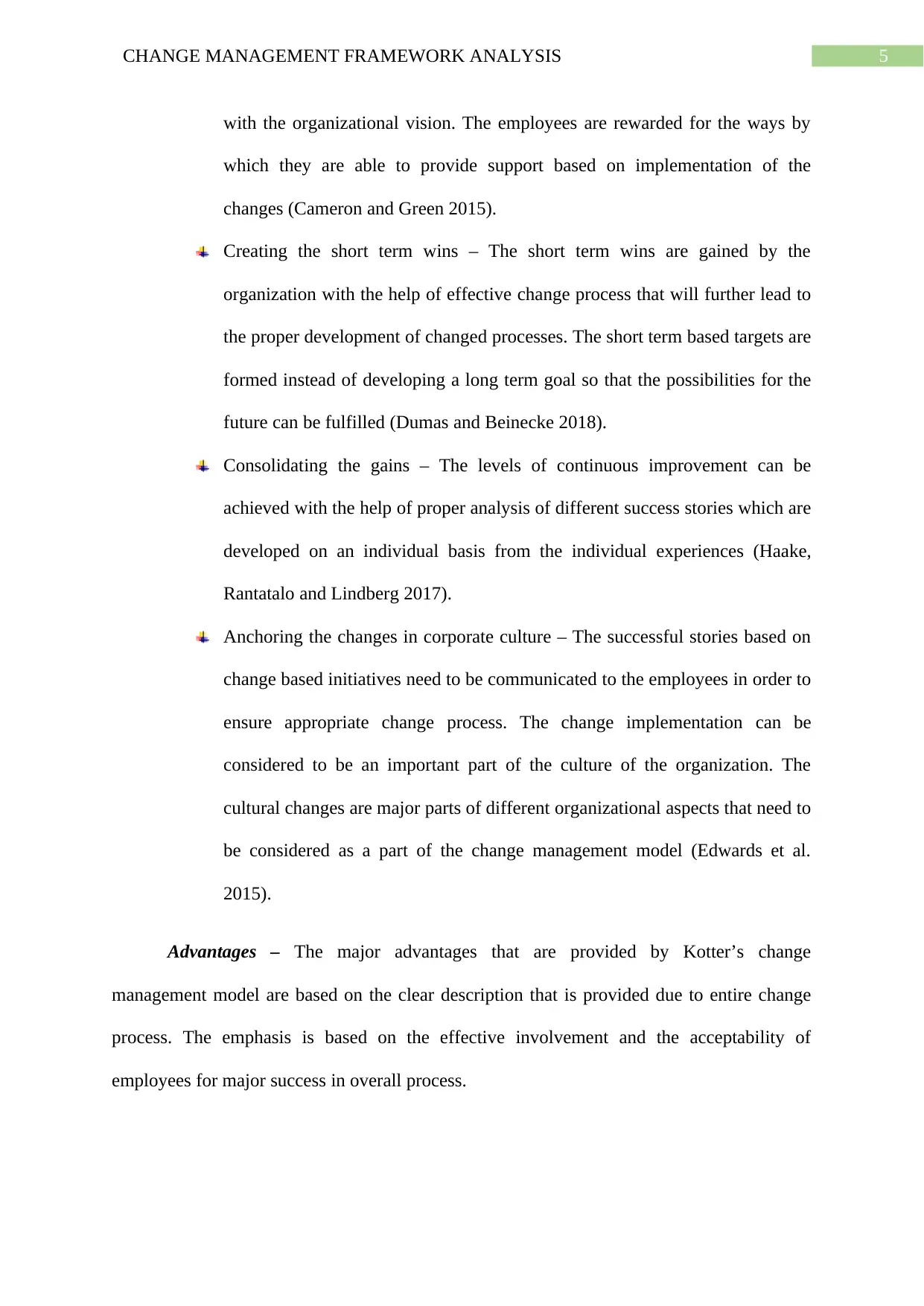
5CHANGE MANAGEMENT FRAMEWORK ANALYSIS
with the organizational vision. The employees are rewarded for the ways by
which they are able to provide support based on implementation of the
changes (Cameron and Green 2015).
Creating the short term wins – The short term wins are gained by the
organization with the help of effective change process that will further lead to
the proper development of changed processes. The short term based targets are
formed instead of developing a long term goal so that the possibilities for the
future can be fulfilled (Dumas and Beinecke 2018).
Consolidating the gains – The levels of continuous improvement can be
achieved with the help of proper analysis of different success stories which are
developed on an individual basis from the individual experiences (Haake,
Rantatalo and Lindberg 2017).
Anchoring the changes in corporate culture – The successful stories based on
change based initiatives need to be communicated to the employees in order to
ensure appropriate change process. The change implementation can be
considered to be an important part of the culture of the organization. The
cultural changes are major parts of different organizational aspects that need to
be considered as a part of the change management model (Edwards et al.
2015).
Advantages – The major advantages that are provided by Kotter’s change
management model are based on the clear description that is provided due to entire change
process. The emphasis is based on the effective involvement and the acceptability of
employees for major success in overall process.
with the organizational vision. The employees are rewarded for the ways by
which they are able to provide support based on implementation of the
changes (Cameron and Green 2015).
Creating the short term wins – The short term wins are gained by the
organization with the help of effective change process that will further lead to
the proper development of changed processes. The short term based targets are
formed instead of developing a long term goal so that the possibilities for the
future can be fulfilled (Dumas and Beinecke 2018).
Consolidating the gains – The levels of continuous improvement can be
achieved with the help of proper analysis of different success stories which are
developed on an individual basis from the individual experiences (Haake,
Rantatalo and Lindberg 2017).
Anchoring the changes in corporate culture – The successful stories based on
change based initiatives need to be communicated to the employees in order to
ensure appropriate change process. The change implementation can be
considered to be an important part of the culture of the organization. The
cultural changes are major parts of different organizational aspects that need to
be considered as a part of the change management model (Edwards et al.
2015).
Advantages – The major advantages that are provided by Kotter’s change
management model are based on the clear description that is provided due to entire change
process. The emphasis is based on the effective involvement and the acceptability of
employees for major success in overall process.
⊘ This is a preview!⊘
Do you want full access?
Subscribe today to unlock all pages.

Trusted by 1+ million students worldwide
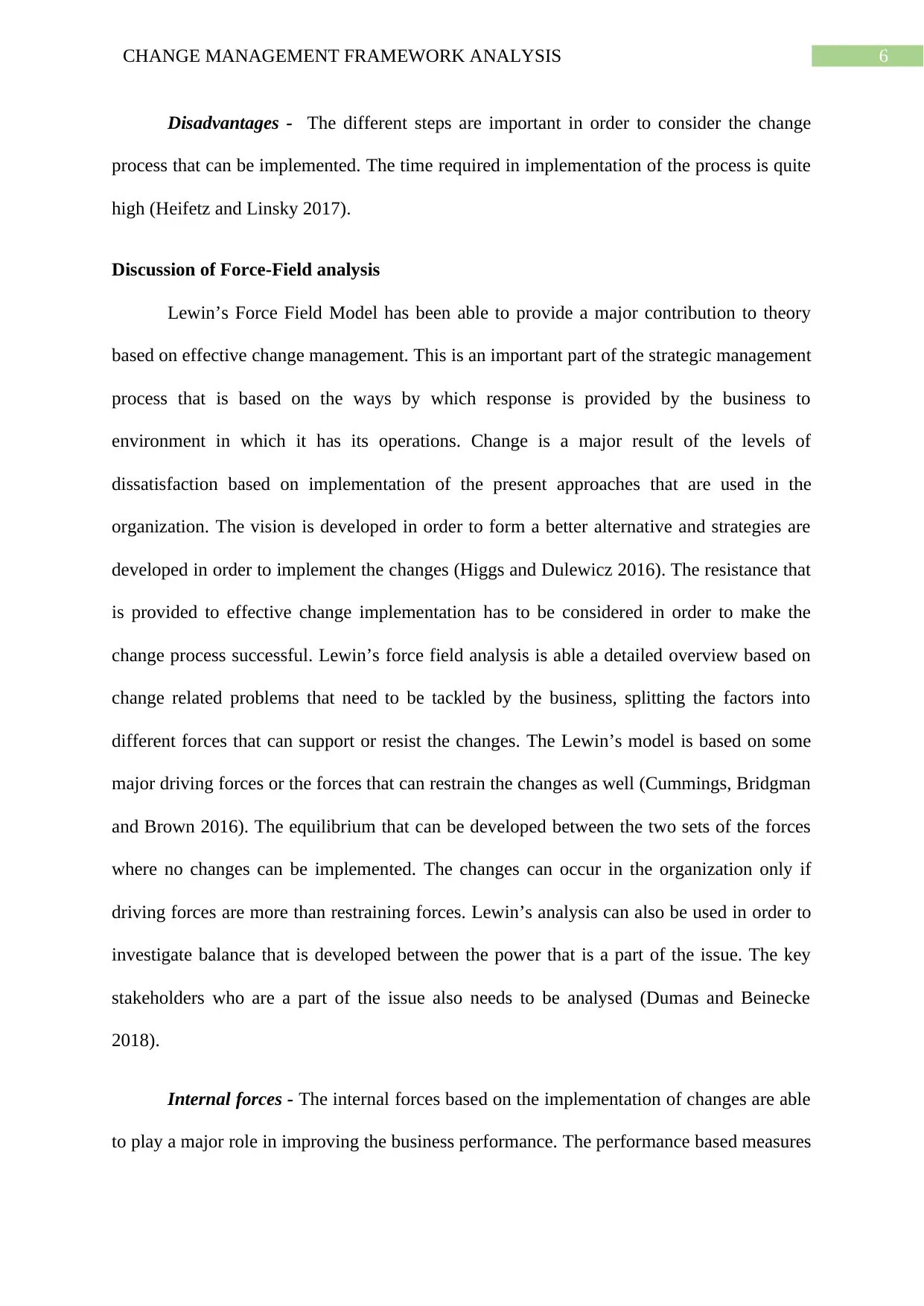
6CHANGE MANAGEMENT FRAMEWORK ANALYSIS
Disadvantages - The different steps are important in order to consider the change
process that can be implemented. The time required in implementation of the process is quite
high (Heifetz and Linsky 2017).
Discussion of Force-Field analysis
Lewin’s Force Field Model has been able to provide a major contribution to theory
based on effective change management. This is an important part of the strategic management
process that is based on the ways by which response is provided by the business to
environment in which it has its operations. Change is a major result of the levels of
dissatisfaction based on implementation of the present approaches that are used in the
organization. The vision is developed in order to form a better alternative and strategies are
developed in order to implement the changes (Higgs and Dulewicz 2016). The resistance that
is provided to effective change implementation has to be considered in order to make the
change process successful. Lewin’s force field analysis is able a detailed overview based on
change related problems that need to be tackled by the business, splitting the factors into
different forces that can support or resist the changes. The Lewin’s model is based on some
major driving forces or the forces that can restrain the changes as well (Cummings, Bridgman
and Brown 2016). The equilibrium that can be developed between the two sets of the forces
where no changes can be implemented. The changes can occur in the organization only if
driving forces are more than restraining forces. Lewin’s analysis can also be used in order to
investigate balance that is developed between the power that is a part of the issue. The key
stakeholders who are a part of the issue also needs to be analysed (Dumas and Beinecke
2018).
Internal forces - The internal forces based on the implementation of changes are able
to play a major role in improving the business performance. The performance based measures
Disadvantages - The different steps are important in order to consider the change
process that can be implemented. The time required in implementation of the process is quite
high (Heifetz and Linsky 2017).
Discussion of Force-Field analysis
Lewin’s Force Field Model has been able to provide a major contribution to theory
based on effective change management. This is an important part of the strategic management
process that is based on the ways by which response is provided by the business to
environment in which it has its operations. Change is a major result of the levels of
dissatisfaction based on implementation of the present approaches that are used in the
organization. The vision is developed in order to form a better alternative and strategies are
developed in order to implement the changes (Higgs and Dulewicz 2016). The resistance that
is provided to effective change implementation has to be considered in order to make the
change process successful. Lewin’s force field analysis is able a detailed overview based on
change related problems that need to be tackled by the business, splitting the factors into
different forces that can support or resist the changes. The Lewin’s model is based on some
major driving forces or the forces that can restrain the changes as well (Cummings, Bridgman
and Brown 2016). The equilibrium that can be developed between the two sets of the forces
where no changes can be implemented. The changes can occur in the organization only if
driving forces are more than restraining forces. Lewin’s analysis can also be used in order to
investigate balance that is developed between the power that is a part of the issue. The key
stakeholders who are a part of the issue also needs to be analysed (Dumas and Beinecke
2018).
Internal forces - The internal forces based on the implementation of changes are able
to play a major role in improving the business performance. The performance based measures
Paraphrase This Document
Need a fresh take? Get an instant paraphrase of this document with our AI Paraphraser
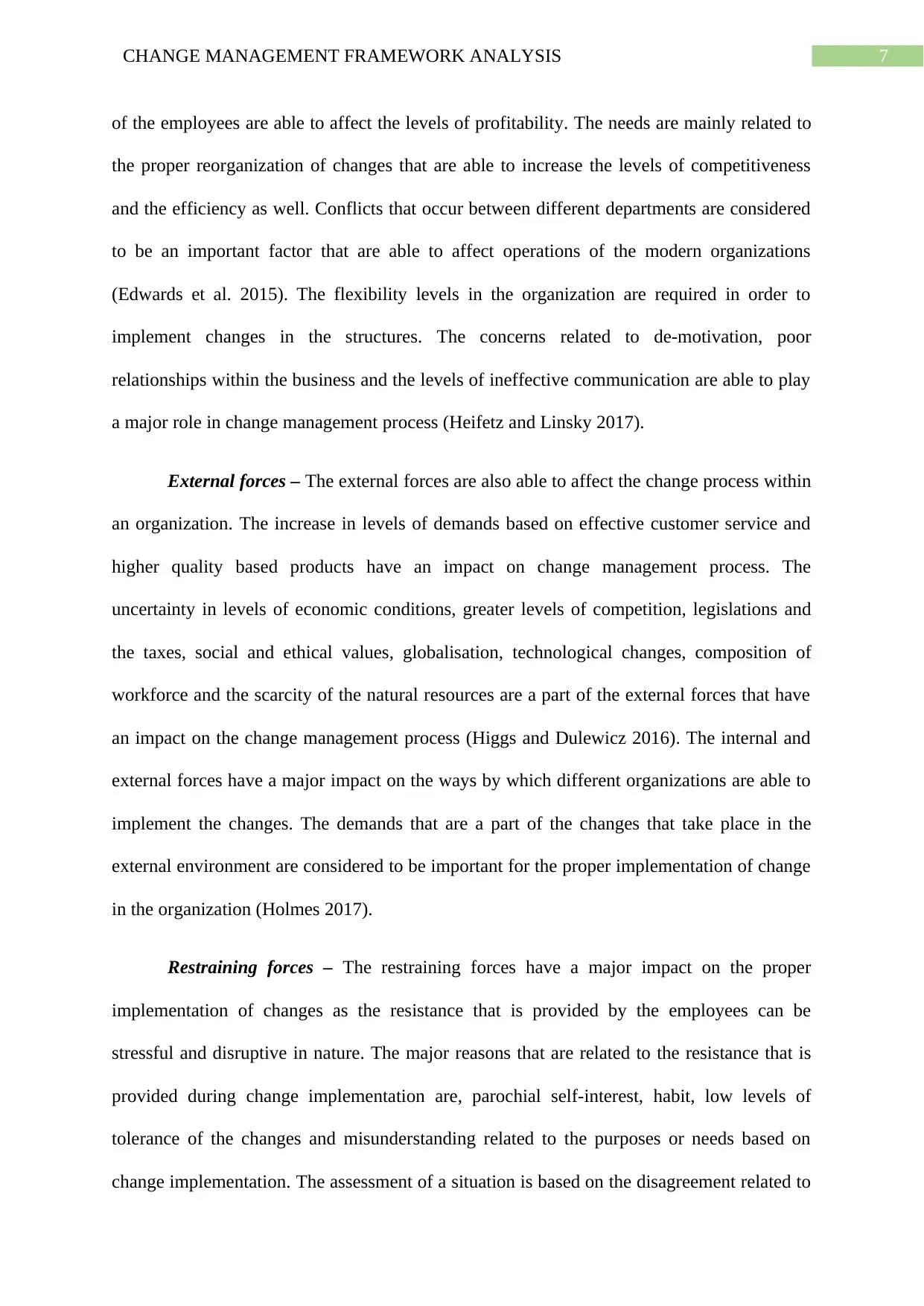
7CHANGE MANAGEMENT FRAMEWORK ANALYSIS
of the employees are able to affect the levels of profitability. The needs are mainly related to
the proper reorganization of changes that are able to increase the levels of competitiveness
and the efficiency as well. Conflicts that occur between different departments are considered
to be an important factor that are able to affect operations of the modern organizations
(Edwards et al. 2015). The flexibility levels in the organization are required in order to
implement changes in the structures. The concerns related to de-motivation, poor
relationships within the business and the levels of ineffective communication are able to play
a major role in change management process (Heifetz and Linsky 2017).
External forces – The external forces are also able to affect the change process within
an organization. The increase in levels of demands based on effective customer service and
higher quality based products have an impact on change management process. The
uncertainty in levels of economic conditions, greater levels of competition, legislations and
the taxes, social and ethical values, globalisation, technological changes, composition of
workforce and the scarcity of the natural resources are a part of the external forces that have
an impact on the change management process (Higgs and Dulewicz 2016). The internal and
external forces have a major impact on the ways by which different organizations are able to
implement the changes. The demands that are a part of the changes that take place in the
external environment are considered to be important for the proper implementation of change
in the organization (Holmes 2017).
Restraining forces – The restraining forces have a major impact on the proper
implementation of changes as the resistance that is provided by the employees can be
stressful and disruptive in nature. The major reasons that are related to the resistance that is
provided during change implementation are, parochial self-interest, habit, low levels of
tolerance of the changes and misunderstanding related to the purposes or needs based on
change implementation. The assessment of a situation is based on the disagreement related to
of the employees are able to affect the levels of profitability. The needs are mainly related to
the proper reorganization of changes that are able to increase the levels of competitiveness
and the efficiency as well. Conflicts that occur between different departments are considered
to be an important factor that are able to affect operations of the modern organizations
(Edwards et al. 2015). The flexibility levels in the organization are required in order to
implement changes in the structures. The concerns related to de-motivation, poor
relationships within the business and the levels of ineffective communication are able to play
a major role in change management process (Heifetz and Linsky 2017).
External forces – The external forces are also able to affect the change process within
an organization. The increase in levels of demands based on effective customer service and
higher quality based products have an impact on change management process. The
uncertainty in levels of economic conditions, greater levels of competition, legislations and
the taxes, social and ethical values, globalisation, technological changes, composition of
workforce and the scarcity of the natural resources are a part of the external forces that have
an impact on the change management process (Higgs and Dulewicz 2016). The internal and
external forces have a major impact on the ways by which different organizations are able to
implement the changes. The demands that are a part of the changes that take place in the
external environment are considered to be important for the proper implementation of change
in the organization (Holmes 2017).
Restraining forces – The restraining forces have a major impact on the proper
implementation of changes as the resistance that is provided by the employees can be
stressful and disruptive in nature. The major reasons that are related to the resistance that is
provided during change implementation are, parochial self-interest, habit, low levels of
tolerance of the changes and misunderstanding related to the purposes or needs based on
change implementation. The assessment of a situation is based on the disagreement related to
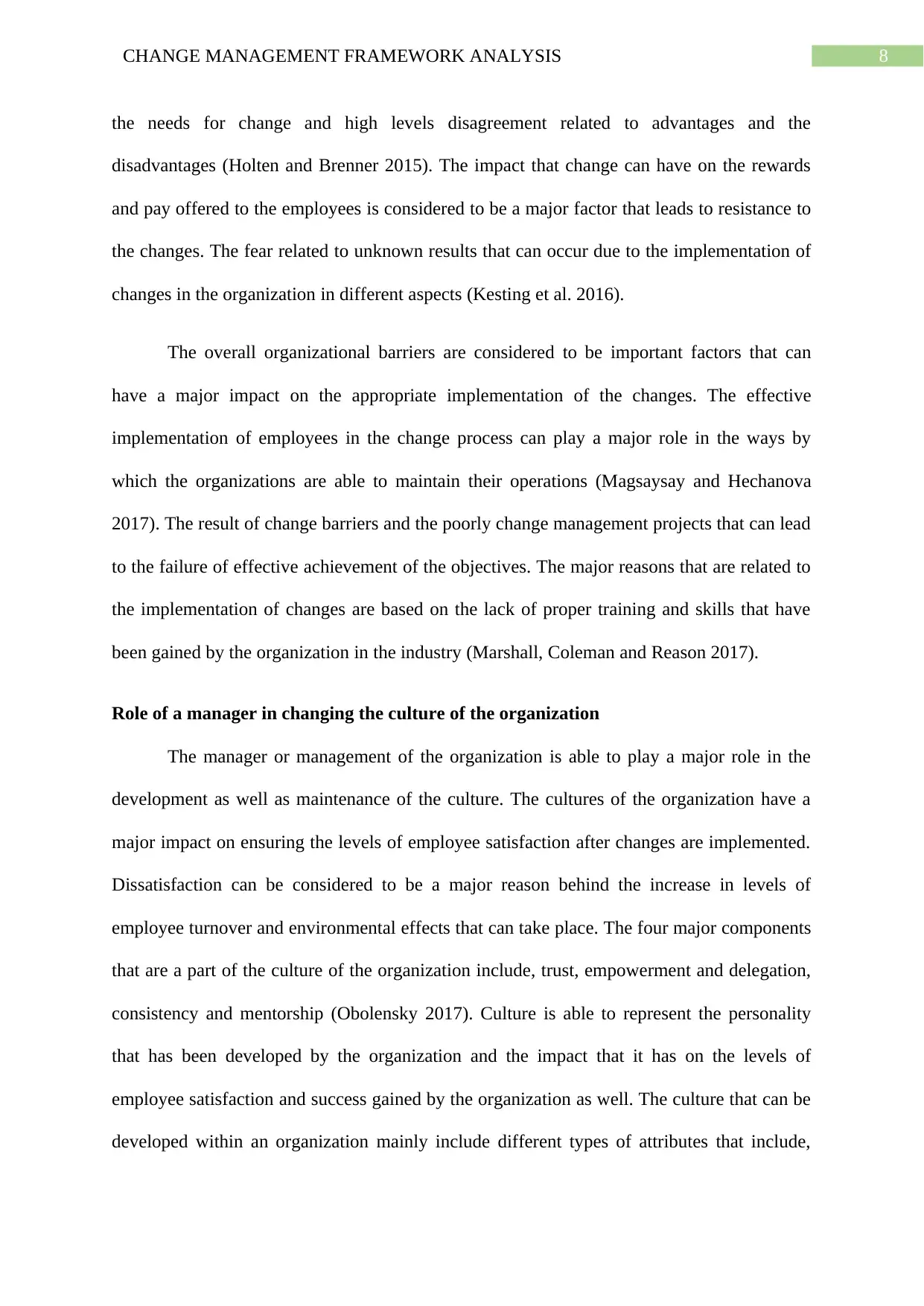
8CHANGE MANAGEMENT FRAMEWORK ANALYSIS
the needs for change and high levels disagreement related to advantages and the
disadvantages (Holten and Brenner 2015). The impact that change can have on the rewards
and pay offered to the employees is considered to be a major factor that leads to resistance to
the changes. The fear related to unknown results that can occur due to the implementation of
changes in the organization in different aspects (Kesting et al. 2016).
The overall organizational barriers are considered to be important factors that can
have a major impact on the appropriate implementation of the changes. The effective
implementation of employees in the change process can play a major role in the ways by
which the organizations are able to maintain their operations (Magsaysay and Hechanova
2017). The result of change barriers and the poorly change management projects that can lead
to the failure of effective achievement of the objectives. The major reasons that are related to
the implementation of changes are based on the lack of proper training and skills that have
been gained by the organization in the industry (Marshall, Coleman and Reason 2017).
Role of a manager in changing the culture of the organization
The manager or management of the organization is able to play a major role in the
development as well as maintenance of the culture. The cultures of the organization have a
major impact on ensuring the levels of employee satisfaction after changes are implemented.
Dissatisfaction can be considered to be a major reason behind the increase in levels of
employee turnover and environmental effects that can take place. The four major components
that are a part of the culture of the organization include, trust, empowerment and delegation,
consistency and mentorship (Obolensky 2017). Culture is able to represent the personality
that has been developed by the organization and the impact that it has on the levels of
employee satisfaction and success gained by the organization as well. The culture that can be
developed within an organization mainly include different types of attributes that include,
the needs for change and high levels disagreement related to advantages and the
disadvantages (Holten and Brenner 2015). The impact that change can have on the rewards
and pay offered to the employees is considered to be a major factor that leads to resistance to
the changes. The fear related to unknown results that can occur due to the implementation of
changes in the organization in different aspects (Kesting et al. 2016).
The overall organizational barriers are considered to be important factors that can
have a major impact on the appropriate implementation of the changes. The effective
implementation of employees in the change process can play a major role in the ways by
which the organizations are able to maintain their operations (Magsaysay and Hechanova
2017). The result of change barriers and the poorly change management projects that can lead
to the failure of effective achievement of the objectives. The major reasons that are related to
the implementation of changes are based on the lack of proper training and skills that have
been gained by the organization in the industry (Marshall, Coleman and Reason 2017).
Role of a manager in changing the culture of the organization
The manager or management of the organization is able to play a major role in the
development as well as maintenance of the culture. The cultures of the organization have a
major impact on ensuring the levels of employee satisfaction after changes are implemented.
Dissatisfaction can be considered to be a major reason behind the increase in levels of
employee turnover and environmental effects that can take place. The four major components
that are a part of the culture of the organization include, trust, empowerment and delegation,
consistency and mentorship (Obolensky 2017). Culture is able to represent the personality
that has been developed by the organization and the impact that it has on the levels of
employee satisfaction and success gained by the organization as well. The culture that can be
developed within an organization mainly include different types of attributes that include,
⊘ This is a preview!⊘
Do you want full access?
Subscribe today to unlock all pages.

Trusted by 1+ million students worldwide
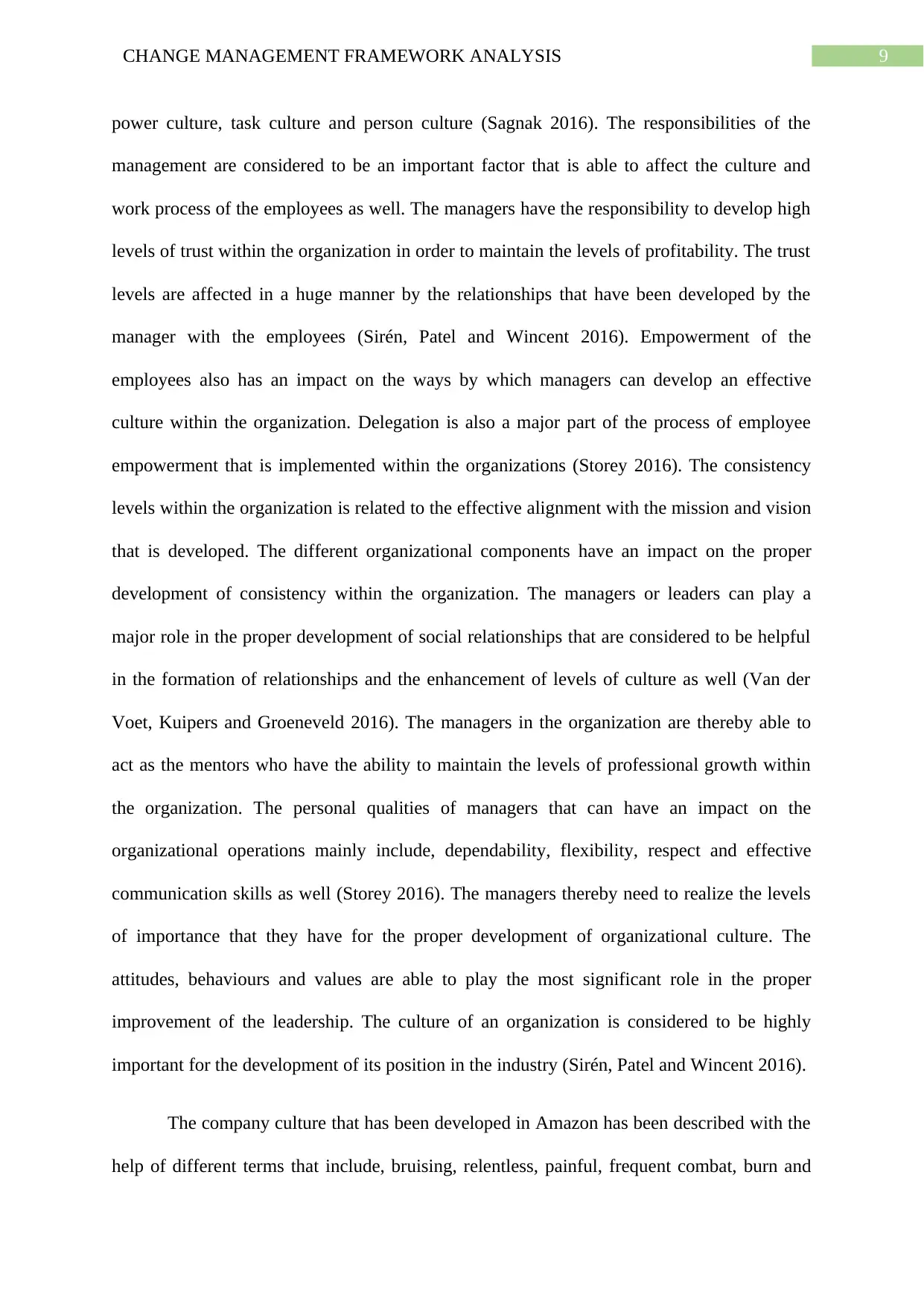
9CHANGE MANAGEMENT FRAMEWORK ANALYSIS
power culture, task culture and person culture (Sagnak 2016). The responsibilities of the
management are considered to be an important factor that is able to affect the culture and
work process of the employees as well. The managers have the responsibility to develop high
levels of trust within the organization in order to maintain the levels of profitability. The trust
levels are affected in a huge manner by the relationships that have been developed by the
manager with the employees (Sirén, Patel and Wincent 2016). Empowerment of the
employees also has an impact on the ways by which managers can develop an effective
culture within the organization. Delegation is also a major part of the process of employee
empowerment that is implemented within the organizations (Storey 2016). The consistency
levels within the organization is related to the effective alignment with the mission and vision
that is developed. The different organizational components have an impact on the proper
development of consistency within the organization. The managers or leaders can play a
major role in the proper development of social relationships that are considered to be helpful
in the formation of relationships and the enhancement of levels of culture as well (Van der
Voet, Kuipers and Groeneveld 2016). The managers in the organization are thereby able to
act as the mentors who have the ability to maintain the levels of professional growth within
the organization. The personal qualities of managers that can have an impact on the
organizational operations mainly include, dependability, flexibility, respect and effective
communication skills as well (Storey 2016). The managers thereby need to realize the levels
of importance that they have for the proper development of organizational culture. The
attitudes, behaviours and values are able to play the most significant role in the proper
improvement of the leadership. The culture of an organization is considered to be highly
important for the development of its position in the industry (Sirén, Patel and Wincent 2016).
The company culture that has been developed in Amazon has been described with the
help of different terms that include, bruising, relentless, painful, frequent combat, burn and
power culture, task culture and person culture (Sagnak 2016). The responsibilities of the
management are considered to be an important factor that is able to affect the culture and
work process of the employees as well. The managers have the responsibility to develop high
levels of trust within the organization in order to maintain the levels of profitability. The trust
levels are affected in a huge manner by the relationships that have been developed by the
manager with the employees (Sirén, Patel and Wincent 2016). Empowerment of the
employees also has an impact on the ways by which managers can develop an effective
culture within the organization. Delegation is also a major part of the process of employee
empowerment that is implemented within the organizations (Storey 2016). The consistency
levels within the organization is related to the effective alignment with the mission and vision
that is developed. The different organizational components have an impact on the proper
development of consistency within the organization. The managers or leaders can play a
major role in the proper development of social relationships that are considered to be helpful
in the formation of relationships and the enhancement of levels of culture as well (Van der
Voet, Kuipers and Groeneveld 2016). The managers in the organization are thereby able to
act as the mentors who have the ability to maintain the levels of professional growth within
the organization. The personal qualities of managers that can have an impact on the
organizational operations mainly include, dependability, flexibility, respect and effective
communication skills as well (Storey 2016). The managers thereby need to realize the levels
of importance that they have for the proper development of organizational culture. The
attitudes, behaviours and values are able to play the most significant role in the proper
improvement of the leadership. The culture of an organization is considered to be highly
important for the development of its position in the industry (Sirén, Patel and Wincent 2016).
The company culture that has been developed in Amazon has been described with the
help of different terms that include, bruising, relentless, painful, frequent combat, burn and
Paraphrase This Document
Need a fresh take? Get an instant paraphrase of this document with our AI Paraphraser
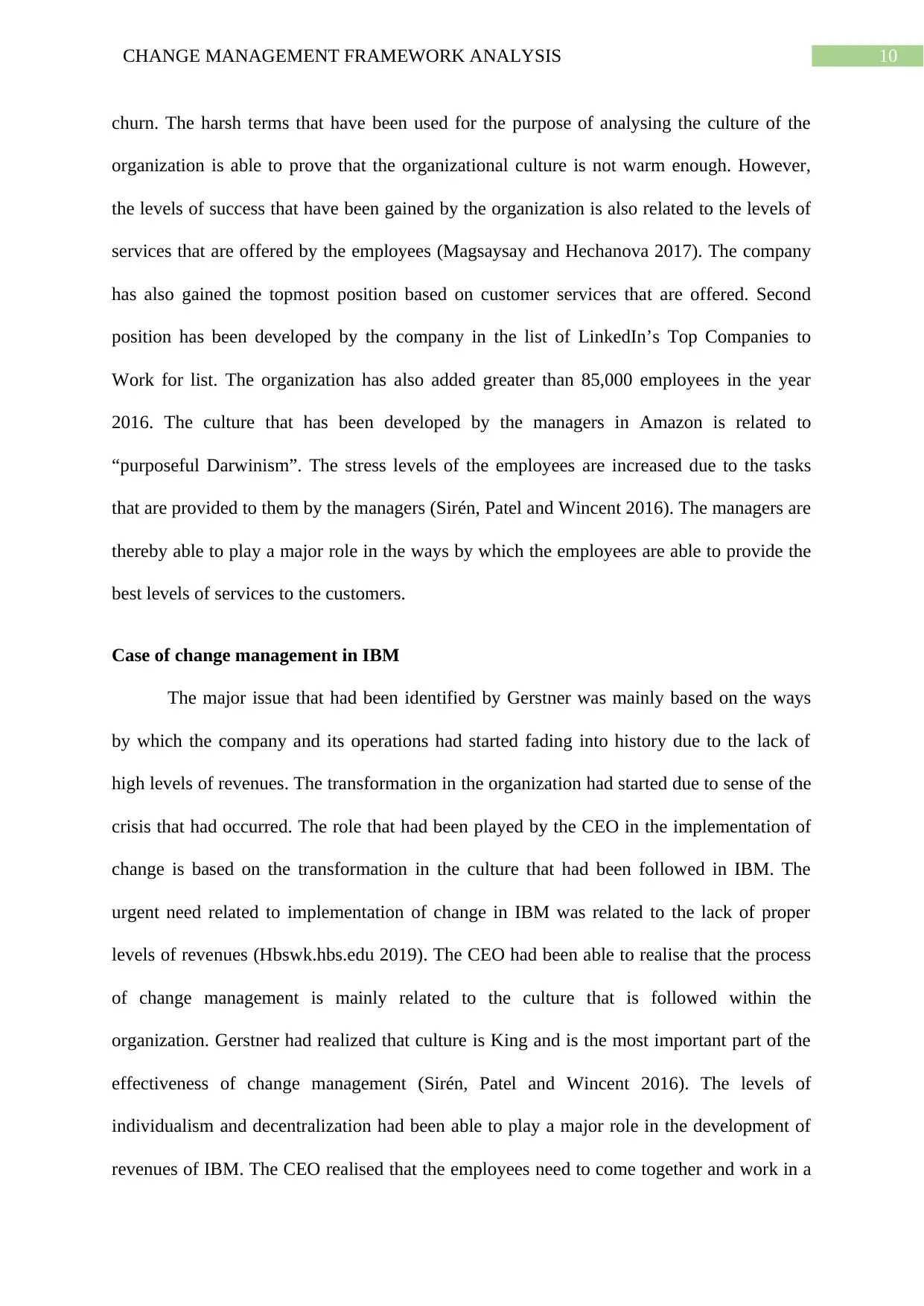
10CHANGE MANAGEMENT FRAMEWORK ANALYSIS
churn. The harsh terms that have been used for the purpose of analysing the culture of the
organization is able to prove that the organizational culture is not warm enough. However,
the levels of success that have been gained by the organization is also related to the levels of
services that are offered by the employees (Magsaysay and Hechanova 2017). The company
has also gained the topmost position based on customer services that are offered. Second
position has been developed by the company in the list of LinkedIn’s Top Companies to
Work for list. The organization has also added greater than 85,000 employees in the year
2016. The culture that has been developed by the managers in Amazon is related to
“purposeful Darwinism”. The stress levels of the employees are increased due to the tasks
that are provided to them by the managers (Sirén, Patel and Wincent 2016). The managers are
thereby able to play a major role in the ways by which the employees are able to provide the
best levels of services to the customers.
Case of change management in IBM
The major issue that had been identified by Gerstner was mainly based on the ways
by which the company and its operations had started fading into history due to the lack of
high levels of revenues. The transformation in the organization had started due to sense of the
crisis that had occurred. The role that had been played by the CEO in the implementation of
change is based on the transformation in the culture that had been followed in IBM. The
urgent need related to implementation of change in IBM was related to the lack of proper
levels of revenues (Hbswk.hbs.edu 2019). The CEO had been able to realise that the process
of change management is mainly related to the culture that is followed within the
organization. Gerstner had realized that culture is King and is the most important part of the
effectiveness of change management (Sirén, Patel and Wincent 2016). The levels of
individualism and decentralization had been able to play a major role in the development of
revenues of IBM. The CEO realised that the employees need to come together and work in a
churn. The harsh terms that have been used for the purpose of analysing the culture of the
organization is able to prove that the organizational culture is not warm enough. However,
the levels of success that have been gained by the organization is also related to the levels of
services that are offered by the employees (Magsaysay and Hechanova 2017). The company
has also gained the topmost position based on customer services that are offered. Second
position has been developed by the company in the list of LinkedIn’s Top Companies to
Work for list. The organization has also added greater than 85,000 employees in the year
2016. The culture that has been developed by the managers in Amazon is related to
“purposeful Darwinism”. The stress levels of the employees are increased due to the tasks
that are provided to them by the managers (Sirén, Patel and Wincent 2016). The managers are
thereby able to play a major role in the ways by which the employees are able to provide the
best levels of services to the customers.
Case of change management in IBM
The major issue that had been identified by Gerstner was mainly based on the ways
by which the company and its operations had started fading into history due to the lack of
high levels of revenues. The transformation in the organization had started due to sense of the
crisis that had occurred. The role that had been played by the CEO in the implementation of
change is based on the transformation in the culture that had been followed in IBM. The
urgent need related to implementation of change in IBM was related to the lack of proper
levels of revenues (Hbswk.hbs.edu 2019). The CEO had been able to realise that the process
of change management is mainly related to the culture that is followed within the
organization. Gerstner had realized that culture is King and is the most important part of the
effectiveness of change management (Sirén, Patel and Wincent 2016). The levels of
individualism and decentralization had been able to play a major role in the development of
revenues of IBM. The CEO realised that the employees need to come together and work in a
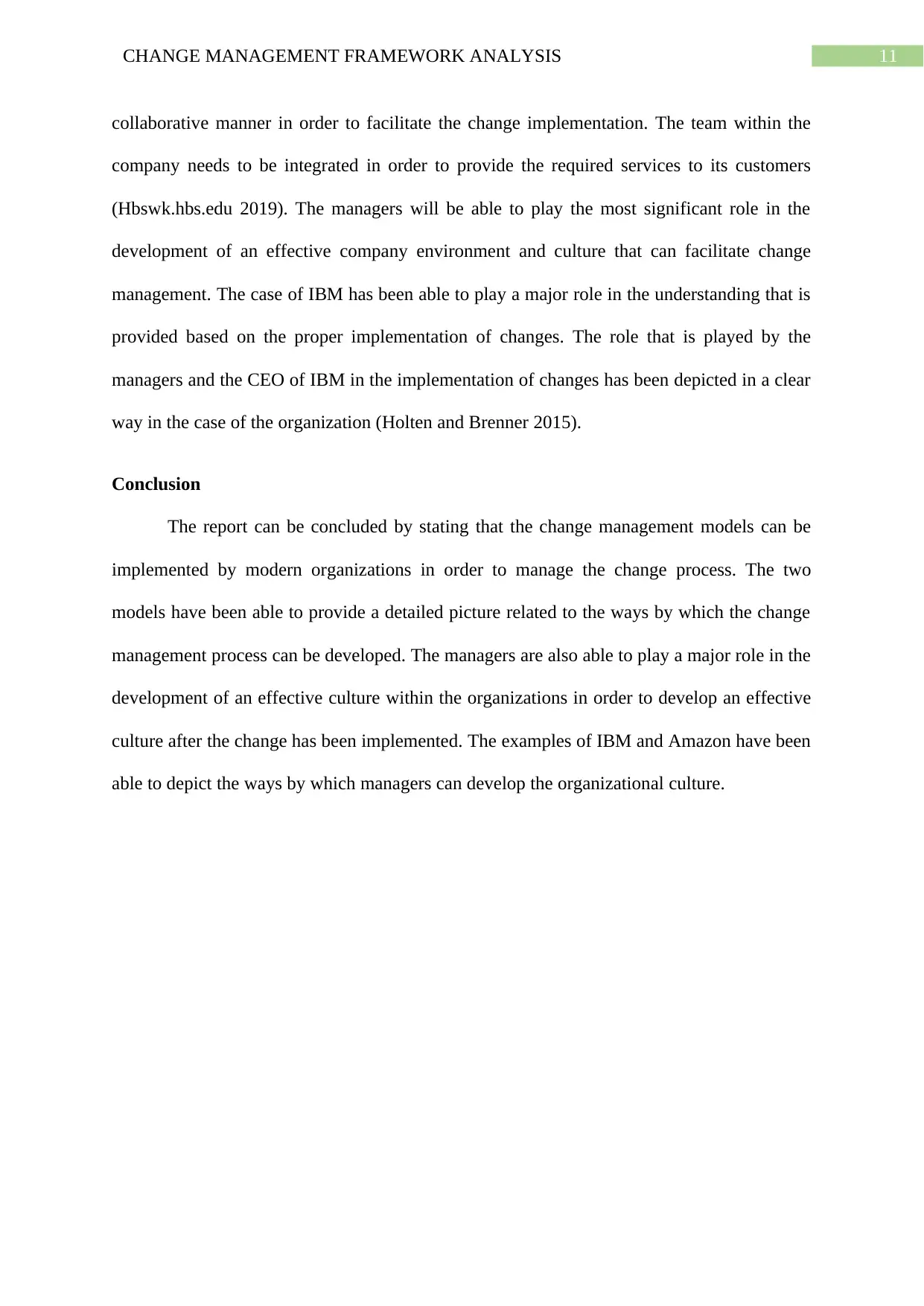
11CHANGE MANAGEMENT FRAMEWORK ANALYSIS
collaborative manner in order to facilitate the change implementation. The team within the
company needs to be integrated in order to provide the required services to its customers
(Hbswk.hbs.edu 2019). The managers will be able to play the most significant role in the
development of an effective company environment and culture that can facilitate change
management. The case of IBM has been able to play a major role in the understanding that is
provided based on the proper implementation of changes. The role that is played by the
managers and the CEO of IBM in the implementation of changes has been depicted in a clear
way in the case of the organization (Holten and Brenner 2015).
Conclusion
The report can be concluded by stating that the change management models can be
implemented by modern organizations in order to manage the change process. The two
models have been able to provide a detailed picture related to the ways by which the change
management process can be developed. The managers are also able to play a major role in the
development of an effective culture within the organizations in order to develop an effective
culture after the change has been implemented. The examples of IBM and Amazon have been
able to depict the ways by which managers can develop the organizational culture.
collaborative manner in order to facilitate the change implementation. The team within the
company needs to be integrated in order to provide the required services to its customers
(Hbswk.hbs.edu 2019). The managers will be able to play the most significant role in the
development of an effective company environment and culture that can facilitate change
management. The case of IBM has been able to play a major role in the understanding that is
provided based on the proper implementation of changes. The role that is played by the
managers and the CEO of IBM in the implementation of changes has been depicted in a clear
way in the case of the organization (Holten and Brenner 2015).
Conclusion
The report can be concluded by stating that the change management models can be
implemented by modern organizations in order to manage the change process. The two
models have been able to provide a detailed picture related to the ways by which the change
management process can be developed. The managers are also able to play a major role in the
development of an effective culture within the organizations in order to develop an effective
culture after the change has been implemented. The examples of IBM and Amazon have been
able to depict the ways by which managers can develop the organizational culture.
⊘ This is a preview!⊘
Do you want full access?
Subscribe today to unlock all pages.

Trusted by 1+ million students worldwide
1 out of 16
Related Documents
Your All-in-One AI-Powered Toolkit for Academic Success.
+13062052269
info@desklib.com
Available 24*7 on WhatsApp / Email
![[object Object]](/_next/static/media/star-bottom.7253800d.svg)
Unlock your academic potential
Copyright © 2020–2025 A2Z Services. All Rights Reserved. Developed and managed by ZUCOL.




